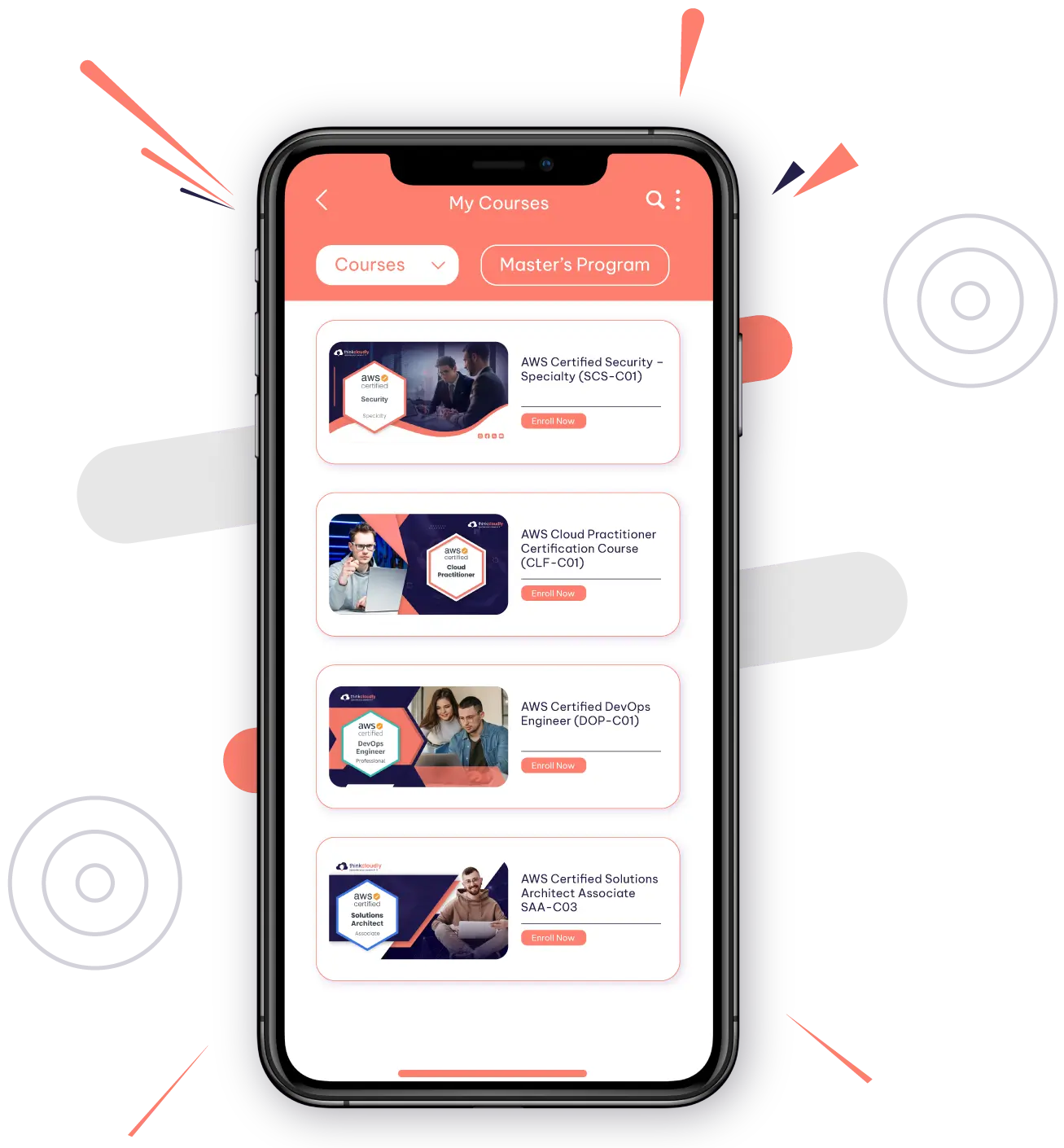Introduction
AWS Cloud Security is very important for those organizations that have AWS as a cloud service provider. AWS comes with a great number of cloud security features but it is up to the user to implement the cloud security functions and make sure they are implementing them correctly.
If you are on the verge of giving an interview for the AWS Cloud Security Position then you must be aware of the AWS security features and functionalities and how to implement them.
Cloud security interview questions often assess your knowledge of these aspects. Mostly this topic is covered in AWS Cloud Security training and course and every student is taught how to implement security. Here, we’ll explore the most frequently asked AWS Cloud Security interview questions and answers to boost your chances of success in the AWS field.
List of the top most asked AWS Cloud Security Interview questions and answers
you must brush up to increase your chances of success in the AWS field
1. What is AWS Cloud Security?
AWS Cloud Security is a set of best practices, guidelines, policies, and technology that is often recommended to protect your data, infrastructure and applications within the AWS environment. It includes various security measures which include access control, threat detection, compliance management, and data encryption to ensure that the integrity of the AWS resource is maintained.
2. What is AWS IAM and how does it work?
With AWS Identity and Access Management, one can centrally manage and control who has access to AWS resources. You can create and manage roles within your AWS account. IAM works with a permission model meaning it has a function called as “Least Privilege” meaning you can control and give permissions to anyone only for specific tasks. You’ll likely encounter questions on IAM during cloud security interview questions.
3. How can you secure data at rest with AWS?
Data at rest can be secured using various methods in AWS as follows;
- Amazon S3: Use client-side encryption before uploading the data or utilize server-side encryption (SSE) with AWS key management service (KMS).
- Amazon RDS: Enable encryption at the instance level using AWS key management service (KMS).
- Amazon EBS: Encrypt EBS volumes using AWS KMS or third-party solutions.
- AWS Glacier: Enable vault lock to enforce data retention policies and compliance.
4. What are the best practices for using AWS IAM?
Some best practices using AWS IAM include;
- Use Least Privilege: Grant users specific roles and permissions needed to perform their tasks.
- Use strong passwords and multi-factor authentication: Make sure all IAM users are using strong passwords and multi-factor authentication at all times.
- Use IAM roles for applications and services: Instead of using IAM users to access AWS resources, use IAM roles for applications and resources.
- Use IAM groups to manage permissions: Create IAM groups to manage permissions for users and roles.
- Monitor IAM activity: Use Cloudtrail to monitor IAM activity and identify any suspicious activity.
5. What is AWS Cloudtrail and how does it work?
AWS Cloudtrail is a service that keeps a record of all the API calls made to your AWS account. Basically, this helps keep track of all the users, and user activity, troubleshoot problems, and audit your AWS account. Cloudtrail works by recording all the API calls to your AWS account in an audit trail. Audit trails are recorded in Amazon S3 buckets, where one can review and analyze them.
6. How can you monitor and detect security threats in AWS?
AWS has inbuilt services for monitoring and detecting threats including;
- AWS CloudTrail: Records API activity that detects unauthorized access and track changes.
- Amazon CloudWatch: Provides logs and detailed metrics to monitor AWS resources.
- Amazon GuardDuty: A managed threat detection service that uses machine learning to identify potential security breaches.
- Amazon Inspector: Helps assess the compliance and security of AWS resources.
7. What are the best practices for using AWS CloudTrail?
AWS records account activity across the AWS platform as it is a logging service. But to leverage AWS CloudTrail services users must configure it to make most of the governance, security, and compliance capabilities available.
- Enable CloudTrail for all regions: The user must enable CloudTrail for all regions where one has resources.
- Create a Trail: Trails help keep track of your monitored resources and recorded events will be sent.
- Retain audit trails for a long period of time: To retain the trail for a sufficient period of time to comply with the organization’s security policies.
- Protecting audit trails: Protecting audit trails from unauthorized users and making sure they are stored in a safe location by encrypting them.
- Monitoring Audit Trails: To keep an eye on suspicious activity.
8. What is AWS Security Hub and how does it work?
AWS Security Hub is a bird’s eye view of your AWS security posture. Security Hub aggregates security alerts from a variety of sources, such as CloudTrail GuardDuty and Inspector. You can use Security Hub to view your security alerts in one place guard them and investigate them on a priority basis.
9. What are the best practices for using AWS Security Hub?
Here are the best practices for using a security hub
- Enabling security hub for all regions: Enabling the Security Hub where all resources are kept.
- Enable all Security Hub standard controls: To get a comprehensive view of the security posture Security Hub standard controls are enabled.
- Configure Security Hub to integrate with other security services: Configure Security Hub to integrate with other security services like CloudTrail, GuradDuty, and Inspector.
10. Explain in detail the concept of AWS Virtual Private Cloud and its importance in security.
With AWS VPC you can launch a logically isolated virtual private network. This VPN will have similarities to a traditional network that you will use to operate in your own data center with the benefits of using the scalable infrastructure of AWS. It helps you define network topology, control inbound and outbound traffic, and help set up network security groups and NACLs (Network Access Control Lists).
11. What is AWS Key Management Service (KMS) and how does it help in data encryption?
AWS KMS (Key Management Service) gets you centralised control to the encryption keys. It helps in data encryption by providing a scalable and secure way to manage cryptographic keys to encrypt and decrypt data in AWS.
12. How can you secure an AWS account against unauthorized access?
- Enable Multifactor authentication.
- Update strong passwords.
- Regularly manage IAM permissions to minimize access.
- Enable AWS CloudTrail for monitoring account activity.
13. What is AWS Well-Architected Framework and why is it important for security?
Helps you understand the trade-offs for decisions you make while building workloads on AWS. By using AWS’s well-architected framework you can learn the best architectural practices for designing and operating reliable, secure, scalable cost-effective workloads in the cloud.
14. How can you secure AWS Lambda functions?
- Use IAM with roles and least privilege to keep control over the users.
- Encrypt sensitive data and environment variables.
- Enable VPC configurations for functions.
- Set up AWS Lambda resource policies for controlled access.
15. What is AWS GuardDuty and how does it work?
AWS GuardDuty is an add-on service that monitors malicious and suspicious activity in AWS. GuardDuty uses machine learning to identify malicious activity in AWS.
16. What are AWS Security Groups, and how do they work?
AWS Security Groups are virtual firewalls that control inbound and outbound traffic for EC2 instances and other resources within AWS. They work by defining rules that allow or disallow traffic based on port ranges and protocol.
17. What is WAF (Web Application Firewall) and its importance?
AWS Web Application Firewall protects applications from getting exploited and getting threats. It allows you to filter requests from HTTP and HTTPS on your web applications. AWS WAF is crucial for protecting your web applications against SQL injection attacks.
18. How can you protect against DDoS attacks in AWS?
Understanding how to defend against DDoS attacks is a crucial skill for cloud security professionals. This is a topic you might encounter in cloud security interview questions. AWS offers several services to help you mitigate DDoS attacks, including:
- AWS Shield: This is a managed DDoS protection service.
- Amazon CloudFront: A CDN that will help mitigate DDoS attacks.
- Amazon Route 53: This has a DNS service with a DDoS protection feature.
19. Everything about AWS Artifact service and how it can help improve security?
AWS Artifact helps provide on-demand access to AWS compliance documentation. It helps organizations prepare for security audits and assessments.
20. What are AWS trusted advisors and how do they help with the security of AWS?
It helps understand unintended resource access in AWS thereby enhancing security.
By understanding these cloud security interview questions and their answers, you’ll be well-equipped to showcase your AWS security expertise in your next interview. Remember, consistent practice answering cloud security interview questions can significantly improve your confidence and interview performance.”












No comment yet, add your voice below!